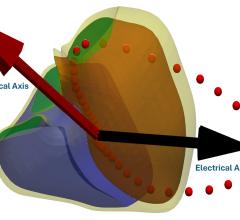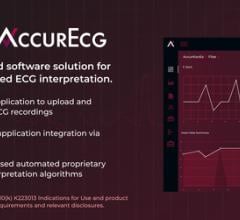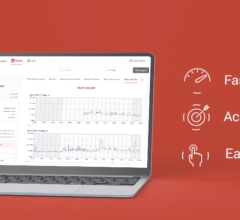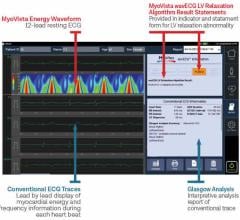
The TMI Spectre wireless foot switch can help eliminate cords in the cath lab.
April 7, 2011 — The American College of Cardiology (ACC) 2011 in New Orleans this week offered an expo floor filled with hundreds of cardiovascular products. The following five technologies stood out as my editor’s choice for innovation that addresses needs in cardiology.
Immediate, Interactive ECGs on the iPad
The rapid proliferation of the iPhone/iPad in medicine prompted GE Healthcare to partner with AirStrip to enable electrocardiograph (ECG) waveforms to be accessed anywhere.
The AirStrip secure mobile app allows access to precise, nearly real-time cardiac information from the GE Muse Cardiology Information System. It enables a continuous flow of ECG data and interactive historical data. Cedars-Sinai Medical Center in Los Angeles, Texas Health Resources and several other large hospitals and healthcare systems will soon be live with AirStrip Cardiology.
Today, remote physicians commonly view 12- and 15-lead ECG data from static scanned JPG images, which requires computer access. These images easily distort when zooming, making it a challenge to read critical changes as small as 0.5 mm. AirStrip Cardiology’s high resolution can detect such small differences through completely interactive iPad or iPhone views. Zooming in on waveforms does not affect visual clarity. Clinicians can view current data and historical tests conducted up to one year ago, in 10-second increments.
GE expects the system to be particularly useful in situations requiring emergency evaluation of suspected elevated ST-segment myocardial infarction (STEMI). Cardiologists can make a quick diagnosis, regardless of whether they are at lunch or home at 3 a.m., to determine if the cath lab needs to be activated.
AirStrip recently announced a similar pre-hospital ECG interface between Physio-Control’s defibrillator-monitors and physicians’ smart phones to enable earlier activation of the cath lab to help reduce door-to-balloon times.
Echo Images Processed for CT-Like Image Quality
Last year at ACC 2010, Ziosoft unveiled its Phyziodynamic advanced visualization software, which uses super-computing algorithms to convert computed tomography (CT) data sets of a full cardiac cycle into crystal-clear, color cine loops. These loops can be fully manipulated, rotating on any axis, and can be sliced through so the heart is in motion, showing true anatomical function that only previously would be seen by surgeons working on beating hearts. One of the keys to the software is its filtering ability to remove about 95 percent or more of noise that can obscure areas with artifacts.
This technology is now being applied to cardiac ultrasound (echo) 3-D volumes, and the first examples were demonstrated as a works-in-progress at ACC. On clear volume acquisitions, the software can create false color 3-D images and 4-D cine loops that are nearly as sharp and detailed as a CT scan. Similar to the Phyziodynamic CT images, moving cine loops can be manipulated with rotation and sliced from any angle with simple mouse navigation. The technology can be used to enhance previously acquired or archived 3-D echo volumes.
At ACC, I was able to compare the enhanced Ziosoft echo images with the state-of-the-art, high-end 3-D/4-D echo systems offered by several key vendors. While the quality of the images provided by the vendors’ systems is superb, this new technology being pioneered by Ziosoft may be able to bring echo on par with CT image quality in the near future. With major trends to reduce patient radiation dose and an increasing use of ultrasound, this technology is definitely one to watch.
Stethoscope Integrates Six-Lead ECG
Newer stethoscopes by Thinklabs and Littman/3M released in the past couple of years allow heart sounds to be recorded and transmitted to other physicians. A new device at this year’s ACC takes this a step further with an integrated, easy-to-use six-lead ECG system.
Parace M.D. introduced its Ekoscope, a pocket-sized device that is currently pending U.S. Food and Drug Administration (FDA) clearance. It combines the benefits of an electronic stethoscope, including USB-enabled data sync capability to PC and Internet, and heart sound amplification. It also has the dual capacity to record six-lead ECGs using three different modes. Additionally, it has a pen light with converging twin beams of adjustable brightness LED light.
Powered by a concealed USB and lithium ion rechargeable battery, Ekoscope offers 2-gigabyte SD storage for heart sounds, ECG recordings and playback. Static or video waveforms are displayed on a color LCD screen, which incorporates an intuitive touch-key interface. The earpiece can be detached and interchanged with a stereo speaker for teaching and collaboration.
The six-lead ECG is accomplished with four metal points on the base of the device, which are placed against the patient’s skin. The two additional leads are connected by the patient touching metal contacts on the head of the device with both the left and right hand.
More Radiation Protection Without the Weight
Heavy lead aprons worn in the cath lab create progressive back pain and can eventually cause irreversible damage to the spine. This is a concern on the minds of many interventionalists. The extra weight also can fatigue physicians with heavy caseloads.
A new feature in the cath lab display at the Philips Healthcare booth caught my eye, as interventional cardiologists were constantly lined up to try it out. The ZeroGravity Radiation Protection System, developed by CFI Medical Solutions, uses a ceiling-mounted gantry suspension system to carry the weight of a large lead apron suit so the physician does not have to bear that burden.
The ZeroGravity system does not weigh down the user like traditional lead aprons. Instead, all the weight is supported by wires on the gantry, which allows smooth movement along an X, Y, Z axis with little effort.
The apron is longer to offer more protection than traditional aprons and has a leaded glass shield to protect the eyes, head and neck. It offers 1 mm lead equivalency to protect the user from thyroid to groin, which the manufacturer says is twice the protection compared to standard lead aprons. It also offers 0.5 mm protection where previously there was none available.
Contact between the device and the body is minimal, so it provides an open, ventilated feeling, and the operator can easily slip in and out of the apron. The system currently has 20 installs, including cath labs at John Hopkins, the University of Michigan and the University of Utah.
Wireless Angiography Foot and Hand Switches
Another cath lab technology highlighted in the Philips display and elsewhere on the floor was a wireless foot switch for angiography X-ray systems. The TMI Spectre wireless foot and hand switches can eliminate some cables to help detangle the cath lab.
The wireless, encrypted foot switch is offered for use with the Philips single and biplane systems and on GE/OEC series 9800 and 9900 C-arms.





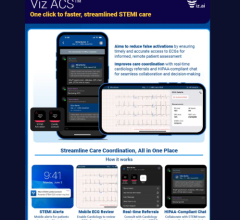
 October 09, 2025
October 09, 2025 



